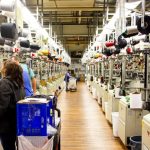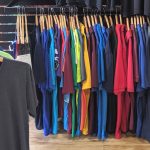S&P Global Ratings reduced its outlook on S&S Activewear to negative, as the imprintable apparel distributor has underperformed the rating agency’s expectations for EBITDA and free operating cash flow (FOCF) since the acquisition of Alphabroder in the second half of 2024, primarily due to continued softness in the promotional products industry.
S&P also forecasts that leverage will remain elevated, with modest free cash flow (FOCF) in 2025.
S&P said, “While we expected the company’s integration of Alphabroder would weigh on S&P Global Ratings-adjusted leverage and cash flow metrics in 2025, the declining revenue trends could keep leverage elevated above our 6.5x downgrade threshold in 2026 despite our expectation for the company to realize the majority of its $90 million planned acquisition synergies.”
S&P affirmed its ratings on S&S Activewear, including the ‘B’ issuer credit rating, and revised its outlook to negative from stable.
The negative outlook reflects the risk that leverage will remain above 6.5x in 2026, likely due to a combination of factors, including industry softness, economic uncertainty, or a failure to realize the majority of planned acquisition synergies with reduced one-time expenses.
S&P said in its analysis, “The outlook revision reflects the risk that S&S Activewear’s leverage will remain elevated above 6.5x in 2025 and 2026 if declining revenue does not stabilize. S&S underperformed relative to our 2024 EBITDA and FOCF expectations, ending the year in a cash flow deficit with S&P Global Ratings-adjusted EBITDA of around $210 million, about $80 million lower than our previous forecast expectations. S&P Global Ratings-adjusted leverage was over 10x in 2024 and around 7.5x pro forma for EBITDA generated by Alphabroder prior to the transaction close. We believe the company’s performance can be attributed to continued softness in the promotional products industry paired with economic uncertainty and modest market share erosion as the company integrates Alphabroder.
“Under our revised forecast, we expect S&P Global Ratings adjusted leverage will improve to the 7x-7.5x area in 2025 and 5.5x-6x in 2026 as the company realizes most of its planned synergies and one-time acquisition costs roll off. While our 2026 leverage forecast is well below our 6.5x downgrade threshold for the rating, we believe there is a risk of leverage staying above 6.5x if the company’s 10 percent first-quarter revenue declines persist into 2026 or if it cannot realize most of its planned synergies and materially reduce one-time costs. The promotional products industry has limited revenue visibility, and S&S Activewear typically has a minimal backlog.
“In our base-case forecast, we expect the company’s S&P Global Ratings-adjusted EBITDA will grow significantly in 2025 and 2026, resulting from significant acquisition cost synergies, lower one-time costs, and the company’s warehouse automation efforts. Despite our expectation for high-single-digit percent pro forma revenue declines in 2025, we expect S&S Activewear to benefit from the realization of significant cost synergies from the Alphabroder acquisition. We expect the acquisition will drive positive EBITDA growth throughout 2025, with the company recognizing about half of its $90 million planned synergies in reported EBITDA in 2025 and about $80 million in 2026. The company has accelerated the realization of cost synergies through the elimination of duplicative expenses related to their distribution network consolidation and by removing redundant corporate infrastructure. In addition, we expect the company to conclude its warehouse automation efforts by the end of 2025, leading to a significant reduction in operating expenses related to employee headcount. Still, execution risk could affect the total benefit and timing of realization and reduction in acquisition-related charges, which poses a risk to our base case forecast. The company’s first-quarter EBITDA generation was weak and our forecast assumes significant EBITDA growth over the remaining three quarters of the year to meet our leverage forecast. While not included in our base case, higher prices could increase the likelihood that S&S Activewear will meet or exceed our forecasted revenue and EBITDA in the second half of 2025. The company’s industry peer, SanMar, enacted a 3.5 percent price increase on June 1, 2025, which could help S&S Activewear increase its own prices without the risk of losing market share. Still, we believe price increases could have a negative impact on order volume, which could offset gains.
“We do not expect tariffs to have a material impact to the company’s 2025 operating performance. We believe the company has a strong relationship with its suppliers, and it has locked in pricing through its mill contracts for the year. The company focuses on soft goods, which are sourced primarily from Central America and Southeast Asia, with minimal exposure to China. Still, U.S. tariffs on its global trade partners could change over time and pose a more significant risk to the business in 2026. The company also intends to enact price increases, which should offset some of the recent volume declines.
“We expect the company to maintain solid liquidity while it continues to navigate industry weakness. The company has ample capacity on its $800 million revolver, with only $30 million drawn and $30.5 million of cash on its balance sheet as of March 31, 2025. We expect modest FOCF generation in 2025 despite the elevated one-time costs and capex due to the company’s focus on working capital management and our expectation for working capital to be a source of cash as revenues contract. The company has demonstrated a conservative financial policy since the acquisition of Alphabroder by repaying over $75 million of costly second-lien debt, which also helps future cash flow. Capex has been elevated to support the company’s warehouse automation plans. We expect about $95 million of capex and this project to be completed by the end of 2025, with capex dropping to around $10 million in 2026.
“The negative outlook reflects the risk that leverage will remain above 6.5x in 2026, likely due to a combination of factors including industry softness, economic uncertainty, or a failure to realize the majority of planned acquisition synergies with reduced one-time expenses.”
Image courtesy S&S Activewear
















